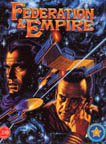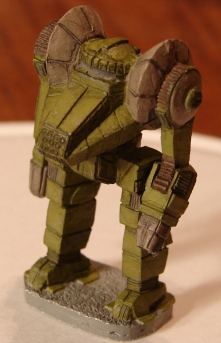 Last week I had the chance to play Federation and Empire, a wargame set in ADB’s Star Fleet Universe. Whereas Star Fleet Battles depicts battles between individual starships, F&E depicts strategic-scale conflict between warring star empires. Each player controls one or more empires (the Federation, the Romulans, the Klingons, etc.); during your own turn, you allocate your empire’s economic resources to build up (or repair) fleets of starships, and then you send those fleets out to capture your opponent’s star systems, destroy his fleets, and (hopefully) drive his economy into the ground.
Last week I had the chance to play Federation and Empire, a wargame set in ADB’s Star Fleet Universe. Whereas Star Fleet Battles depicts battles between individual starships, F&E depicts strategic-scale conflict between warring star empires. Each player controls one or more empires (the Federation, the Romulans, the Klingons, etc.); during your own turn, you allocate your empire’s economic resources to build up (or repair) fleets of starships, and then you send those fleets out to capture your opponent’s star systems, destroy his fleets, and (hopefully) drive his economy into the ground.
I won’t attempt a thorough review of the game here; I only played through a single turn, and am still fuzzy on a lot of the rules. But in short, it’s a very fun, and very demanding, game. It’s demanding both in that it has a lot of rules which must be learned, and also in that it would take a very long time to play through most of the game’s scenarios. (A skilled group of players might be able to get through one of the shorter scenarios in a day or two, but playing through the biggest scenario could easily take months.)
For my first game, I played the Kzinti empire and my opponent played the Lyrans. In the Star Fleet Universe official history, the Lyrans attack the Kzinti, which sparks a World War I-style cascade of alliances and treaties, with the end result of dragging the entire galaxy into war. That sounds fun, but we decided to start small, playing out just the initial Lyran attack and the Kzinti response.
When your turn begins, you fill out an “economic worksheet” for your empire, much like the Energy Allocation stage in Star Fleet Battles. (There’s a joke about tax forms in there somewhere, but I’ll leave it to you to find it.) This is where you spend money to construct military units, and depending on how much tinkering you want to do with your construction schedule, this can take a few minutes or much, much longer. In addition to building new ships, you can repair old ones, or–interestingly–you can “convert” existing ships into other types of ship. (For instance, you might convert an existing cruiser into a carrier.) All of this costs money, of course; at the beginning of the game, I had more money than I could use, but apparently as the game progresses (and your enemies steal territory from you) your empire becomes increasingly low on cash. (After a certain number of turns, for example, your empire’s economy becomes “exhausted” by wartime demand–a clever rule, I thought.)
After completing the economic worksheet, you proceed to the heart of the game: moving vast fleets of starships across a giant map of the galaxy. And by “giant map,” I really mean it–my opponent owned a glorious 30×70″ full-color map that was so cool, I can’t imagine playing F&E without it. (The map that comes in the basic game box is puny in comparison.) You move your fleets into position; your opponent then moves (with some restrictions) his fleets in response, and then battle is joined.
Fleet battles were the most fun part of the game I played. A fleet might have a few or several dozen ships in it, and part of the strategy of doing battle in F&E involves assembling the most effective “battle line.” You can place a certain number of ships from your fleet into the front battle line; there’s also a “second line” where you can place support ships, or ships that for whatever reason you don’t want exposed out on the frontline. Your other ships are kept in reserve, and can be brought up to the battle line later to replace losses.
One interesting aspect of F&E combat is that before battle begins, you and your opponent each choose the “intensity” level with which you want to fight. This basically represents the degree of caution (or recklessness) you want your ships to use in combat. Choosing a low intensity level lowers the amount of damage you can do to the enemy, but also lowers the damage you’ll receive. A high intensity level increases the amount of damage you can inflict, but also increases the risk of suffering massive casualties yourself. If you are greatly outnumbered by your enemy and just want to survive long enough to retreat, you’d probably choose a low intensity; whereas if the situation were reversed and you were trying to wipe out a smaller enemy force, you’d go for a higher intensity.
After that comes the dice-rolling, damage-allocating part of combat. You tally up your total firepower, roll some dice (simultaneously with your opponent), and inflict a certain amount of damage on your enemy. You can choose to target specific ships with your attack (maybe you really, really want to take down a pesky enemy dreadnought), or you can just let your opponent distribute the damage however he likes. (There are advantages and drawbacks to each.) After you’ve taken damage, you can try to withdraw, or proceed to the next round, where you bring up replacements from your reserves and repeat the process.
After combat, some housekeeping and final movement is done, and you wrap up your turn.
That’s F&E from the perspective of a total newbie who played for a grand total of one turn. I found it to be very fun, but also very overwhelming; as with SFB and many other wargames, the basic concepts are not terribly complicated, but there are vast layers of nuance and additional rules you need to master in order to play effectively. And then there’s the time commitment thing. It took most of an afternoon to play through one round of the game, using only two empires. I cannot imagine the amount of time you’d need to play through a full-blown galactic war scenario with all of the major empires in play.
Still, it’s a fun one, and I think I’d like to add it to my game library at some point. I would like to be competent enough with it to play in a game of F&E at Origins later this year. Maybe by the time Origins rolls around, we’ll be up to turn #3…




 by
by 

 Last week I had the chance to play
Last week I had the chance to play 



 How can you not love a book that presents, with a perfectly straight face, the following two lines
How can you not love a book that presents, with a perfectly straight face, the following two lines The portrayal of the Clone Wars in the Star Wars Episodes 1, 2, and 3 has long bothered me. Long, long ago, when I first watched Star Wars and heard crazy old Ben Kenobi’s offhand reference to the Clone Wars (in which he had served alongside Anakin Skywalker, the best starfighter pilot in the galaxy!), my young mind conjured up images of an epic conflict that ravaged the galaxy.
The portrayal of the Clone Wars in the Star Wars Episodes 1, 2, and 3 has long bothered me. Long, long ago, when I first watched Star Wars and heard crazy old Ben Kenobi’s offhand reference to the Clone Wars (in which he had served alongside Anakin Skywalker, the best starfighter pilot in the galaxy!), my young mind conjured up images of an epic conflict that ravaged the galaxy.